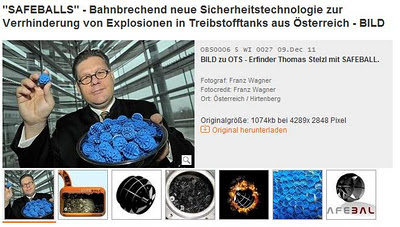| Posted: Dec 9th, 2011 |
| "SAFEBALLS" - Ground-breaking new Safety Technology from Austria Prevents Explosions in Fuel Tanks |
| (Nanowerk News) The Austrian company, SAFEBALL Technology GmbH, has introduced a new, innovative safety technology that significantly reduces the risk of fuel-tank explosions in the civilian and military sectors. The technology in question takes the form of special balls that prevent the ignition of explosive gas mixtures in fuel tanks. They will be available starting in January 2012 under the brand name "SAFEBALL". With a diameter of about 30mm, the balls offer some significant advantages over the use of extruded metal mesh or plastic foams that have been used for more than 40 years. |
| In specific terms, SAFEBALLS® are a spherical filling material that is introduced into the container and completely fills it (liquid or gaseous content, fuels or other chemicals) - either during the construction of the container or at any time afterwards by "blowing them" into the available filler hole in the container. SAFEBALLS® are manufactured out of specially developed, high-performance plastic using nanotechnology. For the spheres, Baytubes® multi-wall carbon nanotubes from Bayer Material-Science AG are being used exclusively worldwide. |
| A container filled with SAFEBALLS® cannot explode, since the explosion is already prevented in its formation stage when explosive gas mixtures are exposed to thermal or mechanical factors (when an aircraft crashes, a military vehicle comes under fire, an automobile accident, etc.). The electrical conductivity of the SAFEBALLS® prevents a static discharge inside the container, thereby eliminating the risk that an explosive gas/air mixture will be ignited by an electrostatic discharge. SAFEBALLS® significantly reduce the evaporation of liquids in the tank and the release of hydrocarbons into the environment as part of the tank "breathing". The balls therefore may make an important contribution to environmental protection in the future. Although the respective container may be completely filled with SAFEBALLS®, the loss of available volume is less than 8% and at approximately 110 g/litre, the weight increase is minor. SAFEBALLS® contain highly active silver ions and therefore have bacteriostatic, fungistatic and algistatic properties. This means that they prevent the formation of fungi, bacteria and algae in the tank. The special shape of the balls allows an undisturbed flow of liquids and gasses, and also neutralizes the dreaded "surge effect." This refers to the displacement of large amounts of liquids when operating road tankers, which impedes stabile operation and can even lead to the vehicle tipping over. The SAFEBALL® balls can be easily sucked out of the tank for cleaning and then reintroduced again after the maintenance work is complete. SAFEBALLS® do not wear out and are maintenance-free. |
| SAFEBALLS® can be equipped with a range of additional functions for special applications. In addition to a fire-fighting capability - in which an extinguishing gel is built into the filling material - these include the option of integrating active and passive transponders in order to store data electronically for protection against vehicle theft or maintenance instructions. |
| The form and manufacture of SAFEBALLS® are under patent protection in major countries around the world and were invented by Austrian, Thomas Stelzl, who received the highest innovation award in Lower Austria for them in November 2010 - the "Karl Ritter von Ghega Award". SAFEBALL Technology GmbH, based in Hirtenberg, Lower Austria, was founded in 2010 and received funding from the AWS - Austria Wirtschaftsservice and the NÖBEG-Niederösterreichische Beteiligungsfinanzierungs GmbH. The shares are held by various private owners, approximately 15 % of which shares belong to three-time Formula 1 champion and airliner, Niki Lauda. |


